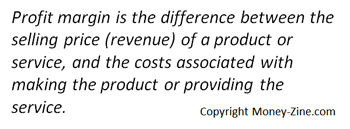One of the key measures of a company's financial wellbeing is its profit margin. This measure is useful because it gives investors insights into a company's ability to control its costs. It's also a concept often confused with mark-up. But as we'll soon see, while the calculation of each measure is different, the two formulas are very much related. In this article, we're going to explain the concept of profit margin. As part of that discussion, we'll talk about the variations of this measure such as gross and net profit margin. We'll also explain the difference between margins and mark-ups. Finally, we'll provide some examples that demonstrate how the measure is calculated.
Corporate Profit Margins
At a very high conceptual level, profit margin can be defined as the difference between the selling price (revenue) of a product or service, and the costs associated with making the product or providing the service. As the name implies, profit margins are a useful measure of the profitability of a company.
Margin versus Mark-Up
The terms profit margin and mark-up are sometimes confused because the terms are somewhat related. Each of these expressions requires only two variables in their calculation: the selling price, and total cost. The formula for each measure is given below: Profit Margin = Selling Price - Total Cost

Mark-up is typically expressed as a percentage of total cost. The formula for this measure is expressed as: Mark-up Percent = (Selling Price - Total Cost) / Total Cost Let's demonstrate the difference using an example, where the total cost to produce and sell a widget is $1.00. We also know the widget sells for $1.30. From this information, it's possible to determine: Profit Margin = $1.30 - $1.00, or $0.30 Mark-up Percentage = ($1.30 - $1.00) / $1.00 = $0.30 / $1.00 = 0.30, or 30% From the above example, it should also be clear there is another way to express the relationship between profit margin and mark-up percentage. Substituting profit margin for (Selling Price - Total Cost) in the mark-up formula yields: Mark-up Percentage = Profit Margin / Total Cost Or Profit Margin = Mark-up Percentage x Total Cost
Gross Profit Margin
One variation of this measure is gross profit margin, also known as gross margin and gross profit rate. This financial metric tells the investor how much money is left over after the cost of goods sold is subtracted from revenue. The measure is calculated as: Gross Profit Margin = Revenue - Cost of Goods Sold It can also be expressed as a percentage of revenues: Gross Margin Percentage = (Revenue - Cost of Goods Sold) / Revenue The cost of goods sold (COGS) includes both fixed as well as the variable expenses associated with the manufacture and sale of a product or service. For example, COGS would include expenses such as raw materials, direct labor, and sales commissions. The COGS does not include indirect expenses such as office expense and administrative costs. While direct comparisons are not usually possible or advisable, manufacturers with higher gross margins are thought to be more efficient at turning raw materials into profits.
Net Profit Margin
The calculation of net profit margin takes the gross margin formula one step further. Instead of just including the cost of goods sold, this formula looks at after tax-profit and compares it to revenues. The measure is calculated as: Net Profit Margin = After Tax Profit / Revenue Net profit margin is another measure of the company's ability to control costs and create profits. Differences in both pricing strategies, as well as manufacturing efficiencies, make it difficult as well as impractical to make comparisons between companies.
Profit Margin Example
As promised, this article is going to finish up with an example that demonstrates these various formulas at work. In the example below, a product sells for $5.00. The total cost to produce the item is $2.50, the cost of goods sold is $2.00, and the after-tax profit is $1.50. Using this information, we know the profit margin: = Selling Price - Total Cost = $5.00 - $2.50 = $2.50 The gross profit margin: = Revenue - Cost of Goods Sold = $5.00 - $2.00 = $3.00 The gross margin percentage: = (Revenue - Cost of Goods Sold) / Revenue = ($5.00 - $2.00) / $5.00 = 0.60 or 60% And finally, the net profit margin: = After Tax Profit / Revenue = $1.50 / $5.00 = 0.30 or 30%
About the Author - Understanding Profit Margins



.jpg)
.jpg)